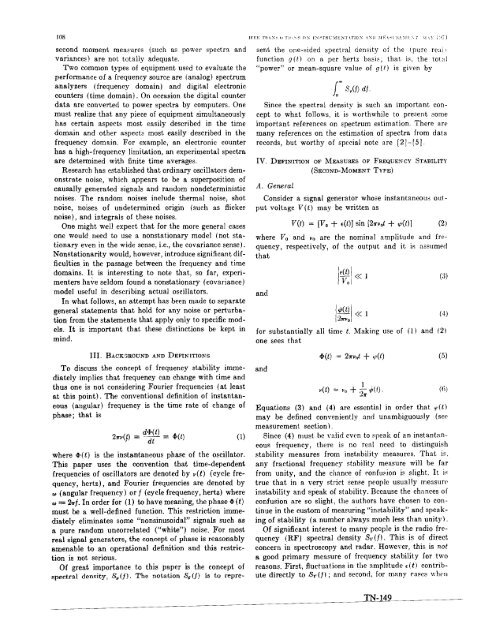NIST Technical Note 1337: Characterization of Clocks and Oscillators
NIST Technical Note 1337: Characterization of Clocks and Oscillators
NIST Technical Note 1337: Characterization of Clocks and Oscillators
Create successful ePaper yourself
Turn your PDF publications into a flip-book with our unique Google optimized e-Paper software.
ID8second moment measures (such as power spectra <strong>and</strong>variances) are not totally adequate.Two common types <strong>of</strong> equipment used to evaluate theperformance <strong>of</strong> a frequency source are (analog) spectrumanalyzers (frequency domain) <strong>and</strong> digital electroniccounters (time domain). On occasion the digital counterdata are converted to power spectra by computers. Onemust realize that any piece <strong>of</strong> equipment simultaneouslyhas certain aspects most easily described in the timedomain <strong>and</strong> other aspects most easily described in thefrequency domain. For example, an electronic counterhas a high-frequency limitation, an experimental spectraare determined with finite time averages.Research has established that ordinary oscillatms demonstratenoise, which appears to be a superposition <strong>of</strong>causally generated signals <strong>and</strong> r<strong>and</strong>om nondeterministicnoises. The r<strong>and</strong>om noises include thermal noise, shotnoise, noises <strong>of</strong> undetermined origin (such as flickernoise), <strong>and</strong> integrals <strong>of</strong> these noises.One might well expect that for the more general casesone would need to use a nonstationary model (not stationaryeven in the wide sense, i.e., the covariance sense).Nonstationarity would, however, introduce significant difficultiesin the passage between the frequency <strong>and</strong> timedomains. It is interesting to note that, so far, experimentershave seldom found a nonstationary (covariance)model useful in describing actual oscillators.In what follows, an attempt has been made to separategeneral statements that hold for any noise or perturbationfrom the statements that apply only to specific models.It is important that these distinctions be kept inmind.III. BACKGROUND AND DEFINITIONSTo discuss the concept <strong>of</strong> frequency stability immediatelyimplies that frequency can change with time <strong>and</strong>thus one is not considering Fourier frequencies (at leastat this point). 'The conventional definition <strong>of</strong> instantaneous(angular) frequency is the time rate <strong>of</strong> change <strong>of</strong>phase; that is(1)where cI>(t) is the instantaneous phase <strong>of</strong> the oscillator.This paper uses the convention that time-dependentfrequencies <strong>of</strong> oscillators are denoted by vet) (cycle frequency,hertz), <strong>and</strong> Fourier frequencies are denoted by"" (angular frequency) or f (cycle frequency, hertz) where'" == Zrrf. In order for (1) to have meaning, the phase cI>(t)must be a well-defined function. This restriction immediatelyeliminates some "nonsinusoidal" signals such asa pure r<strong>and</strong>om uncorrelated ("white") noise. For mostreal signal generators, the concept <strong>of</strong> phase is reasonablyamenable to an operational definition <strong>and</strong> this restrictionis not serious.Of great importance to this paper is the concept <strong>of</strong>spectral density, Sg (I). The notation Sp (I) is to representthe one-sided spectral density <strong>of</strong> the Ipure real Ifunction g (t) on 0. per hertz basis; that is, the tot aI"power" or mean-square value <strong>of</strong> g (t) is given by1~ S,(f) df·Since the spectral density is such an important conceptto what follows, it is worthwhile to present someimportant references on spectrum estimation. There aremany references on the estimation <strong>of</strong> spectra from datarecords, but worthy <strong>of</strong> special note are [2 J- [5 J.IV. DEFINITION OF MEASURES OF FREQUENCY STABILITYA. General(SECOND-MoMENT TYPE)Consider a signal generator whose instantaneou" outputvoltage V (t) may be written asV(t) = [Vo + t(t)J sin [211"vot + 'I'(t)] (2)where V o <strong>and</strong> I'll are the nominal amplitude <strong>and</strong> frequency,respectively, <strong>of</strong> the output <strong>and</strong> it is assumedthat<strong>and</strong>(3)I.~(t) I« I (+)1-""'0for substantially all time t. Making use <strong>of</strong> (l) <strong>and</strong> (2)one sees that<strong>and</strong>4>(t)vet) = Vo + .; .j>(t)._11"Equations (3) <strong>and</strong> (4) are essential in order that 'I'(t)may be defined conveniently <strong>and</strong> unambiguously (seemeasurement section).Since (4) must he valid even to speak <strong>of</strong> an instantaneousfrequency, there is no real need to distinguishstability measures from instability measures. That is,any fractional frequency stability measure will be farfrom unity, <strong>and</strong> the chance <strong>of</strong> confusion is slight. It istrue that in a very strict sense people usually measureinstability <strong>and</strong> speak <strong>of</strong> stability. Because the chances <strong>of</strong>confusion are so slight, the authors have chosen to continuein the custom <strong>of</strong> measuring "instability" <strong>and</strong> speaking<strong>of</strong> stability (a number always much less than unity).Of significant interest to many people is the radio frequency(RF) spectral density S\.(f). This is <strong>of</strong> directconcern in spectroscopy <strong>and</strong> radar. However, this is nota. good primary measure <strong>of</strong> frrquency stability for tworeasons. First, fluctuations in the :lmplitude d t) contributedirectly to 8 1 , (n ; <strong>and</strong> second, for many cases '\'hell(5)TN-149
















